Abstract
Stress-sensing in fungi depends on a signalling cascade comprised of a two-component phosphorylation relay plus a subsequent MAP kinase cascade to trigger gene expression. Besides osmotic or oxidative stress, fungi sense many other environmental factors, one of which is light1,2. Light controls morphogenetic pathways but also the production of secondary metabolites such as penicillin. Here we show that phytochrome-dependent light signalling in Aspergillus nidulans involves the stress-sensing and osmosensing signalling pathway. In a screening for ‘blind’ mutants, the MAP kinase SakA (also known as HogA) was identified by whole-genome sequencing. The phytochrome FphA physically interacted with the histidine-containing phosphotransfer protein YpdA and caused light-dependent phosphorylation of the MAP kinase SakA and its shuttling into nuclei. In the absence of phytochrome, SakA still responded to osmotic stress but not to light. The SakA pathway thus integrates several stress factors and can be considered to be a hub for environmental signals.
This is a preview of subscription content, access via your institution
Access options
Subscribe to this journal
Receive 12 digital issues and online access to articles
$119.00 per year
only $9.92 per issue
Buy this article
- Purchase on Springer Link
- Instant access to full article PDF
Prices may be subject to local taxes which are calculated during checkout




Similar content being viewed by others
References
Rodriguez-Romero, J., Hedtke, M., Kastner, C., Müller, S. & Fischer, R. Fungi, hidden in soil or up in the air: light makes a difference. Annu. Rev. Microbiol. 64, 585–510 (2010).
Dasgupta, A., Fuller, K. K., Dunlap, J. C. & Loros, J. J. Seeing the world differently: variability in the photosensory mechanisms of two model fungi. Environ. Microbiol. 18, 5–20 (2015).
Qiu, L., Wang, J. J., Chu, Z. J., Ying, S. H. & Feng, M. G. Phytochrome controls conidiation in response to red/far-red light and daylight length and regulates multistress tolerance in Beauveria bassiana. Environ Microbiol 16, 2316–2328 (2014).
Yeh, K.-C., Wu, S.-H., Murphy, J. T. & Lagarias, J. C. A cyanobacterial phytochrome two-component light sensory system. Science 277, 1505–1508 (1997).
Karniol, B., Wagner, J. R., Walker, J. M. & Vierstra, R. D. Phylogenetic analysis of the phytochrome superfamily reveals distinct microbial subfamilies of photoreceptors. Biochem. J. 392, 102–116 (2005).
Bhoo, S.-H., Davis, S. J., Walker, J., Karniol, B. & Vierstra, R. D. Bacteriophytochromes are photochromic histidine kinases using a biliverdin chromophore. Nature 414, 776–779 (2001).
Galagan, J. E. et al. Sequencing of Aspergillus nidulans and comparative analysis with A. fumigatus and A. oryzae. Nature 438, 1105–1115 (2005).
Blumenstein, A. et al. The Aspergillus nidulans phytochrome FphA represses sexual development in red light. Curr. Biol. 15, 1833–1838 (2005).
Purschwitz, J. et al. Functional and physical interaction of blue and red-light sensors in Aspergillus nidulans. Curr. Biol. 18, 255–259 (2008).
Hedtke, M. et al. Light-dependent gene activation in Aspergillus nidulans is strictly dependent on phytochrome and involves the interplay of phytochrome and white collar-regulated histone H3 acetylation. Mol. Microbiol. 97, 733–745 (2015).
Ruger-Herreros, C. et al. Regulation of conidiation by light in Aspergillus nidulans. Genetics 188, 809–822 (2011).
Kawasaki, L., Sanchez, O., Shiozaki, K. & Aguirre, J. SakA MAP kinase is involved in stress signal transduction, sexual development and spore viability in Aspergillus nidulans. Mol. Microbiol. 45, 1153–1163 (2002).
Furukawa, K., Hoshi, Y., Maeda, T., Nakajima, T. & Abe, K. Aspergillus nidulans HOG pathway is activated only by two-component signalling pathway in response to osmotic stress. Mol. Microbiol. 56, 1246–1261 (2005).
Mooney, J. L. & Yager, L. N. Light is required for conidiation in Aspergillus nidulans. Genes Dev. 4, 1473–1482 (1990).
Duran, R., Cary, J. W. & Calvo, A. M. Role of the osmotic stress regulatory pathway in morphogenesis and secondary metabolism in filamentous fungi. Toxins 2, 367–381 (2010).
Hohmann, S., Krantz, M. & Nordlander, B. Yeast osmoregulation. Methods Enzymol. 428, 29–45 (2007).
Lara-Rojas, F., Sánchez, O., Kawasaki, L. & Aguirre, J. Aspergillus nidulans transcription factor AtfA interacts with the MAPK SakA to regulate general stress responses, development and spore functions. Mol. Microbiol. 80, 436–454 (2011).
Vargas-Pérez, I., Sánchez, O., Kawasaki, L., Georgellis, D. & Aguirre, J. Response regulators SrrA and SskA are central components of a phosphorelay system involved in stress signal transduction and asexual sporulation in Aspergillus nidulans. Eukaryot. Cell 6, 1570–1583 (2007).
Liscum, E. & Hangarter, R. P. Photomorphogenic mutants of Arabidopsis thaliana reveal activities of multiple photosensory systems during light-stimulated apical-hook opening. Planta 191, 214–221 (1993).
Brandt, S., von Stetten, D., Günther, M., Hildebrandt, P. & Frankenberg-Dinkel, N. The fungal phytochrome FphA from Aspergillus nidulans. J. Biol. Chem. 283, 34605–34614 (2008).
Azuma, N. et al. In vitro analysis of His-Asp phosphorelays in Aspergillus nidulans: The first direct biochemical evidence for the existence of His-Asp phosphotransfer system in filamentous fungi. Biosci. Biotech. Biochem. 71, 2493–2502 (2007).
Röhrig, J., Kastner, C. & Fischer, R. Light inhibits spore germination through phytochrome in Aspergillus nidulans. Curr. Genet. 59, 55–62 (2013).
Fuller, K. K., Ringelberg, C. S., Loros, J. J. & Dunlap, J. C. The fungal pathogen Aspergillus fumigatus regulates growth, metabolism, and stress resistance in response to light. MBio 4, e00142–e00113 (2013).
Rauscher, S., Pacher, S., Hedtke, M., Kniemeyer, O. & Fischer, R. A phosphorylation code of the Aspergillus nidulans global regulator VelvetA (VeA) determines specific functions. Mol Microbiol in press. (2015).
Käfer, E. Meiotic and mitotic recombination in Aspergillus and its chromosomal aberrations. Adv. Genet. 19, 33–131 (1977).
Yelton, M. M., Hamer, J. E. & Timberlake, W. E. Transformation of Aspergillus nidulans by using a trpC plasmid. Proc. Natl Acad. Sci. USA 81, 1470–1474 (1984).
Sambrook, J. & Russel, D. W. Molecular Cloning: A laboratory manual (Cold Spring Harbor Laboratory Press, 1999).
Vienken, K. & Fischer, R. The Zn(II)2Cys6 putative transcription factor NosA controls fruiting body formation in Aspergillus nidulans. Mol. Microbiol. 61, 544–554 (2006).
Herr, A. & Fischer, R. Improvement of Aspergillus nidulans penicillin production by targeting AcvA to peroxisomes. Metab Eng 25, 131–139 (2014).
Toews, M. W. et al. Establishment of mRFP1 as fluorescent marker in Aspergillus nidulans and construction of expression vectors for high-throughput protein tagging using recombination in Escherichia coli (GATEWAY). Curr. Genet. 45, 383–389 (2004).
Acknowledgements
This work was supported by the German Science Foundation (DFG, FOR 1334). Z.Y. was supported by the China Scholarship Council (CSC). We thank E. Wohlmann and B. Schreckenberger for technical assistance and great help with immunostaining. We also would like to thank J. Hübner and C. Streng for some assistance. We are extremely grateful to J. Aguirre (UNAM, Mexico City) for sending us several A. nidulans strains.
Author information
Authors and Affiliations
Contributions
Z.Y. planned and performed the experiments and analysed the data. O.A. was responsible for whole-genome sequencing and analysed the sequencing data. R.F. planned the experiments, analysed the data and wrote the manuscript.
Corresponding author
Ethics declarations
Competing interests
The authors declare no competing financial interests.
Supplementary information
Supplementary Information
Supplementary Figures 1-8 (PDF 4246 kb)
Rights and permissions
About this article
Cite this article
Yu, Z., Armant, O. & Fischer, R. Fungi use the SakA (HogA) pathway for phytochrome-dependent light signalling. Nat Microbiol 1, 16019 (2016). https://doi.org/10.1038/nmicrobiol.2016.19
Received:
Accepted:
Published:
DOI: https://doi.org/10.1038/nmicrobiol.2016.19
This article is cited by
-
MAPkinases regulate secondary metabolism, sexual development and light dependent cellulase regulation in Trichoderma reesei
Scientific Reports (2023)
-
Light regulates the degradation of the regulatory protein VE-1 in the fungus Neurospora crassa
BMC Biology (2022)
-
Use of red, far-red, and near-infrared light in imaging of yeasts and filamentous fungi
Applied Microbiology and Biotechnology (2022)
-
Fatal attraction of Caenorhabditis elegans to predatory fungi through 6-methyl-salicylic acid
Nature Communications (2021)
-
Phytochrome Mediated Responses in Agrobacterium fabrum: Growth, Motility and Plant Infection
Current Microbiology (2021)



